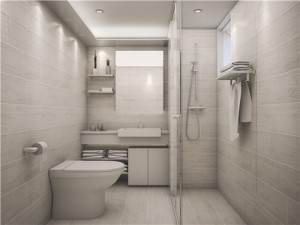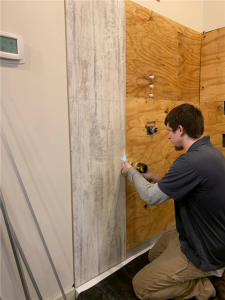When renovating or designing a space, the materials you choose for your walls can have a significant impact on the overall aesthetic, functionality, and longevity of the room. Among the various options available, wall panels and shower panels are both popular choices, especially for areas like bathrooms and living spaces. While these terms might sound similar, they serve different purposes and are designed with specific materials and features in mind. In this article, we’ll explore the key differences between wall panels and shower panels, helping you make an informed decision for your next project.
1. Purpose and Use
The primary distinction between wall panels and shower panels lies in their intended function.
- Wall Panels: Wall panels are versatile coverings designed for a variety of interior spaces. They can be used to cover walls in living rooms, bedrooms, kitchens, offices, and even bathrooms. The purpose of wall panels is often twofold: decorative and protective. They can enhance the visual appeal of a room, improve insulation, or even reduce noise. While they can be installed in wet areas like bathrooms, they are generally not designed to withstand constant exposure to water.
- Shower Panels: Shower panels, on the other hand, are specifically designed for wet environments. These panels are commonly used in shower areas, around bathtubs, or in any area of the bathroom that is exposed to constant moisture and high humidity. Their main function is to provide a waterproof barrier, preventing water from seeping into the walls and causing damage. In addition to moisture resistance, shower panels also help to maintain a hygienic environment by being easy to clean and resistant to mold and mildew growth.

2. Material Composition
The materials used for wall panels and shower panels are crucial in determining their performance, durability, and appearance.
- Wall Panels: Wall panels come in a variety of materials, allowing for a wide range of design possibilities. Some common materials for wall panels include:
- Wood (e.g., plywood or MDF) – Often used for living rooms and bedrooms, providing a natural and warm aesthetic.
- PVC – Lightweight, durable, and easy to maintain, often used in kitchens and bathrooms.
- Drywall (Plasterboard) – Common in residential homes for creating smooth, flat walls.
- Fabric or Acoustic Panels – Used for soundproofing or aesthetic purposes, particularly in offices or home theaters.
- Fiberglass – Provides durability and moisture resistance, often used in lower-humidity areas of bathrooms.
Although many wall panels are moisture-resistant, they are not always fully waterproof. Therefore, they might not be suitable for high-moisture areas like showers unless treated or specially designed for such use.
- Shower Panels: Shower panels are made from materials specifically designed to handle water exposure. These materials include:
- Acrylic – Lightweight, waterproof, and easy to clean. Acrylic panels are one of the most popular choices for shower installations.
- Glass – Provides a sleek, modern look and is highly resistant to water. Glass panels can be used in both traditional and contemporary bathroom designs.
- Fiberglass – Durable, flexible, and moisture-resistant, fiberglass panels are a common choice for shower walls.
- PVC – High-quality PVC shower panels are fully waterproof and often used as an affordable alternative to tiles.
The key here is that shower panels are specifically engineered to withstand continuous exposure to water, preventing damage and ensuring longevity in a high-humidity environment.
3. Design and Aesthetic
- Wall Panels: Wall panels are available in a wide variety of styles and finishes. They can add texture, depth, and character to a room. You’ll find wall panels in wood grain finishes, smooth painted surfaces, or even panels with 3D textures for modern, artistic effects. Whether you prefer a rustic charm, minimalist modernity, or industrial appeal, wall panels can accommodate nearly any interior design style.
For bathrooms and kitchens, wall panels can be customized to suit both functional and decorative needs. For example, you might opt for a sleek, minimalist look using PVC or acrylic wall panels that mimic tile finishes or choose wood panels for a more natural, warm feeling.
- Shower Panels: Shower panels are typically more focused on functionality, with design options often centered around practicality and water resistance. However, this does not mean they lack aesthetic appeal. Modern shower panels are available in sleek finishes like glass, stone effect, and acrylic, often with integrated features like built-in shelving, LED lighting, or shower controls. Many are designed to give a seamless, clean appearance, which is a major trend in contemporary bathrooms.
While shower panels tend to focus on hygiene and moisture resistance, their sleek, modern designs can still add significant aesthetic value to the bathroom. The design can also include elements like built-in jets or misting systems, enhancing the showering experience.

4. Installation and Maintenance
- Wall Panels: Installation of wall panels is relatively simple, depending on the material. Most wall panels can be installed directly onto the existing walls, either using adhesive, screws, or nails. Some materials, like drywall and wood panels, may require professional installation, particularly if you’re looking for a high-quality, finished result. Maintenance for wall panels varies based on the material, but in general, they require occasional cleaning to prevent dust, grime, or water damage (if used in bathrooms).
- Shower Panels: Shower panel installation is similar to wall panels, but with an added emphasis on ensuring proper sealing to prevent water leakage. Shower panels may be more complex to install, especially when dealing with materials like glass or custom designs. It’s crucial to ensure that joints and seams are sealed correctly to avoid water infiltration, which can lead to mold and mildew problems.
As for maintenance, shower panels are designed to be easy to clean and resistant to stains, mold, and mildew. Regular wiping and occasional cleaning with non-abrasive products will keep them looking fresh. Some materials like acrylic are especially easy to maintain, while glass panels may require more regular care to prevent water spots.
5. Cost and Durability
- Wall Panels: Wall panels can range in cost depending on the material. Affordable options like PVC and drywall are budget-friendly, while higher-end materials like wood or custom finishes can be more expensive. However, wall panels are generally more affordable than shower panels, especially when considering the larger surface area that may need to be covered.
In terms of durability, wall panels can last for many years if maintained properly. However, they may need replacing sooner if exposed to high moisture areas without the proper waterproofing or treatment.
- Shower Panels: Shower panels tend to be more expensive due to the specialized materials used to ensure water resistance and durability in a high-moisture environment. Glass and high-quality acrylic panels can carry a higher price tag, but they offer long-lasting performance and aesthetic value. The durability of shower panels is high, as they are designed to withstand constant exposure to water without warping or deterioration.

Conclusion
While wall panels and shower panels may seem similar at first glance, their differences are rooted in their purpose, materials, and installation requirements. Wall panels offer a versatile, aesthetic solution for general interior walls, while shower panels are specially engineered to provide moisture resistance and durability in wet, high-humidity environments like bathrooms.
When deciding between the two, it’s essential to consider the specific needs of your space—whether you’re looking for decorative versatility or a water-resistant solution for your shower area. By choosing the right type of panel, you can ensure both the functionality and the aesthetic appeal of your space.
Post time: Dec-24-2024
